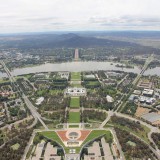Australia
Planned by Walter Burley Griffin and his partner and wife Marion Mahony Griffin (who won a competition). The plans reflected the two main strands of planning popular in the early 1900’s, the immutability of the City Beautiful movement and capturing the landscape and social engineering of the Garden City movement.
Specific reference to the Garden City principles could be seen in the separation of industrial, residential and civic areas by using green areas to create divisions. During its construction Canberra received criticism from many sources, including Garden City advocates, who felt it was ‘disjointed’ and lacked greenbelt space to provide definition.Through the 1960s and 1970s there was little emphasis on the Garden City principles and this led to narrower streets and loss of many front gardens. This culminated in much more densely built housing the 1990s. However contemporary developments are now being built under what Canberra has described as New Garden City values. http://www.planning.act.gov.au/__data/assets/pdf_file/0013/6700/gardencity_values.pdf
Settlement/development timeline
- 1912 Plan submitted to a competition.
- 1913 (12 March) Canberra was established during a naming celebration.
- 1920 Griffin was removed
- 1960s-1970’s there was very little emphasis on garden city principles.
- 1990’s More densely built housing.
Original master planner and any other critical master planning, design and architects:
Planned by Walter Burley Griffin and his partner and wife Marion Mahony Griffin (who won a competition)
Sir John Sulman (architect) who was president of the Town Planning Association of New South Wales laid ground work advocating a number of fundamental ideas
- Preference for single-family housing
- Rejection of terraced housings
- Abolishment of back lanes and front fences
- Use of rounded street intersections
- Extensive tree planting and generous provisions for parks and playgrounds.
Architectural Style/qualities:
- Arts and Crafts
- Spanish Mission Style (1927)
Settlement Size
Currently 814.2 km2 (314.4 sq mi)
Population
Initially intended to house 25,000 381,488 (2013)
Employment Numbers
- Total in labour force – 95,910
- Worked full-time 62,566
- Worked part-time 24,190
- Away from work 6,105
- Unemployed 3,049
- (2011 Census)
Housing/other built form densities
Low-density
Governance arrangements
Part of ACT (Australian Capital Territory) which has internal self-government since 1988.
Other notable features that reflect Garden City Principles
- Well connected and biodiversity rich public parks, and a mix of public and private networks of well managed, high-quality gardens, tree-lined streets and open spaces;
- Distinct separation of the residential, industrial and civic areas and in the use of parks to screen residential neighbourhoods from roads and other undesirable things.
- Strong local jobs offer in the Garden City itself, with a variety of employment opportunities within easy commuting distance of homes
Find out more
http://www.idealcity.org.au
http://www.australia.gov.au/about-australia/australian-story/canberra-australias-capital-city
Access Canberra
Chief Minister, Treasury and Economic Development Directorate
GPO Box 158
Canberra ACT 2601
+61 6207 5111

